Real World History
The Great Migration
Community Exhibition
Free / Online
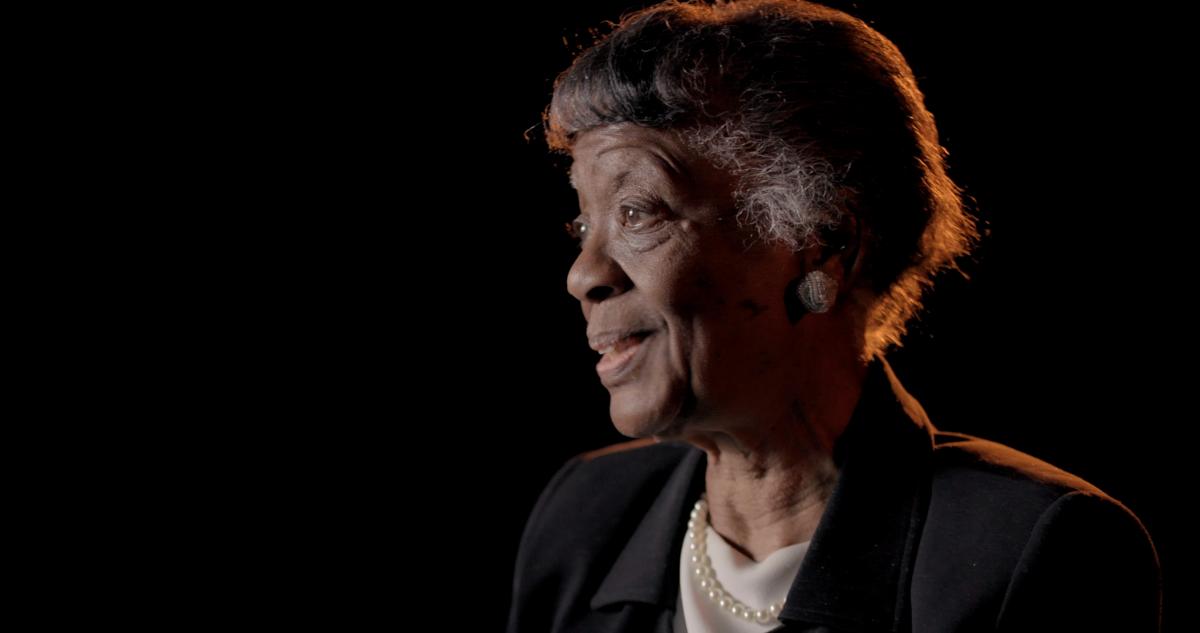
The Great Migration was the mass movement of over 5 million African Americans from the rural South to urban centers in the North and West. Jacob Lawrence’s Migration Series explores the first wave (1916-1940); this exhibition explores the second wave (1940-1970). The Phillips Collection collaborated with high school students in Center for Inspired Teaching’s Real World History class for this project. Using Lawrence’s work as a springboard for conversations about the legacy of the Great Migration and the universal theme of struggle in the world today, the students conducted oral histories of individuals who moved from the South to Washington, DC, prior to 1970. Their stories reveal the courage, faith, hope, and determination of those uprooting themselves in search of a better life.
The short film is modeled after The Migration Series—from life in the South and the decision to leave, to the journey and life in the North. Students also wrote labels for The Migration Series. As you listen to these migration stories and read the students’ responses, think about your own life. What has shaped your destiny? When have you taken risks? What are the key moments in your life journey?
Conduct Your Own Oral History
Click on the panel to read the student responses to The Migration Series
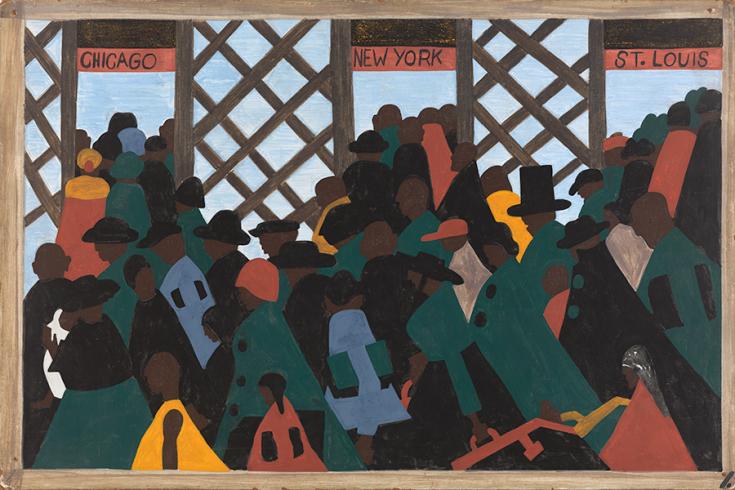
Justine Brandes, 11th Grade, Woodrow Wilson High School:
Imagine packing your whole life into a suitcase and shuffling into a packed train station in hopes of moving north. How would you feel? What would you wear? Would you go alone? Panel 1 shows the abundance of Black Southerners getting on the train to cities like Chicago, New York City, and St. Louis. Some may have been leaving out of fear, some may have left in excitement and hope for the future. But whether they were pushed out of the South or pulled to the North, the train system enabled thousands to start a new life, in what must have seemed like a new world.
Panel no. 1: During World War I there was a great migration north by southern African Americans.
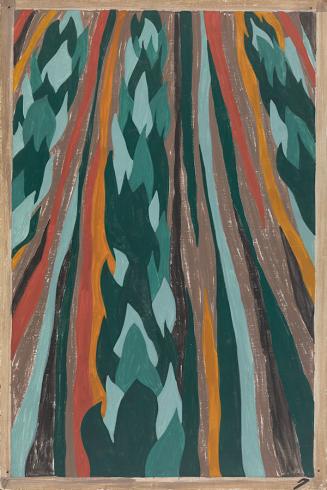
Lawrence Phelps, 11th Grade, Washington Latin Public Charter School
This panel shows us a field with no workers. It represents Black workers migrating from the fields in the South to find a better life. Some Black people thought it was important to stay in the South and fight for education, better jobs, and equal rights. Those who left were sad to leave their loved ones behind; those who stayed couldn’t imagine a life without those loved ones. The ones who fled were faced with lots of hard tasks like bad weather, low food supply/water, and sick kids/elders. But they kept moving because they felt like that was better than dealing with the oppression and depression of poor farmers in a dangerous economy.
Panel no. 7: The migrant, whose life had been rural and nurtured by the earth, was now moving to urban life dependent on industrial machinery.
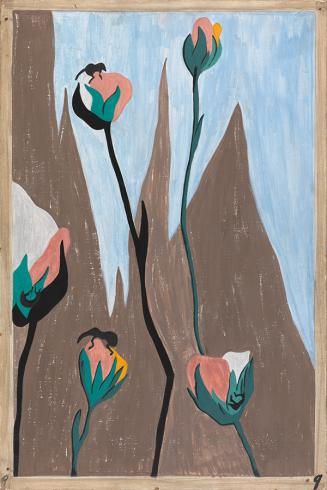
Luca Camponovo, 11th Grade, Washington Latin Public Charter School
A variety of factors enticed and attracted Black migrants to leave the South and venture North. Jacob Lawrence depicts one of the most influential of these push-factors in this portrayal of colorful cotton plants plagued by a boll weevil infestation.
The artist masterfully contrasts the colors green and black, seen in the stems of the plant. These colors give us a feeling of gloom at the sight of death, albeit the death of a crop. This sensation was not foreign to Black Southerners growing cotton or working on cotton plantations, as the death of their crops meant they would be unable to provide for their families. In response, many Southerners decided it was best for them to pack up and move to the North, where they hoped to find new jobs in the North’s growing industrial economy.
Panel no. 9: They left because the boll weevil had ravaged the cotton crop.

Aja Donelson, 10th Grade, KIPP DC College Prep
Will there ever be enough food? Imagine coming home from school. You look in the refrigerator and there’s no food. You look at your mother and all she can do is cry. She repeats, “There’s no food.” What do we do? Where do we go? How do we get ourselves out of this situation? Imagine watching your mother cry as she’s cutting fatback into pieces for your dinner. There’s never gonna be enough. Hungry, tired, those are the things you feel every day as your food gets less and less. Your mother keeps crying because there’s no food. You want to help her, but you can’t. As the days go on you, find yourself almost out of food. You and everyone else is getting desperate for food as the days go by.
Panel no. 11: Food had doubled in price because of the war.
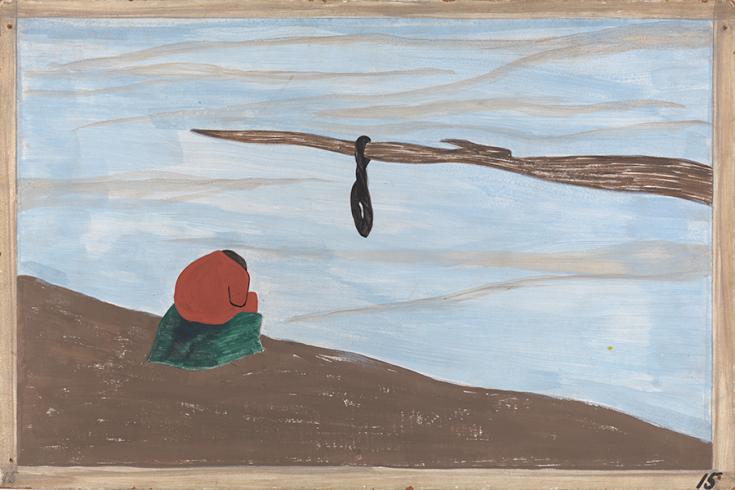
Markaiah Mathis, 10th Grade, KIPP DC College Prep
No More Lynching
As he sits on the rocks with his head down, tears streamed down his face. Looking out at the clear blue sky he prays, he pleads to God. “Why? Why him? How long until we can leave Tennessee?” As he cries out for his brother, he knows there won’t be an answer. His lifeless body clung to that tree the night before and so did so many other Black men. A moment of silence. The only thing he could think about was a different life. A life where Blacks were free at last, where they can be in their own skin. No more lynching.
Panel no. 15: There were lynchings.

Traci Holmer, 12th Grade, Woodrow Wilson High School
These women are very similar, except for the color of their skin. They both drink from a water fountain, with a river flowing between them. Notice that there are more plants on the side with the white woman. We see discrimination that occurred during Jim Crow. Even though Black and white people were guaranteed the same rights under the Constitution, Black people were constantly treated as second class citizens and often abused by a racist society.
The plants also symbolize the accumulation of wealth that each side has. When white planters originally owned slaves, they pocketed the profits from free labor. That wealth divide between African Americans and whites was sustained throughout Jim Crow, which is why there is still a significant economic divide between Blacks and whites today.
Panel no. 19: There had always been discrimination.
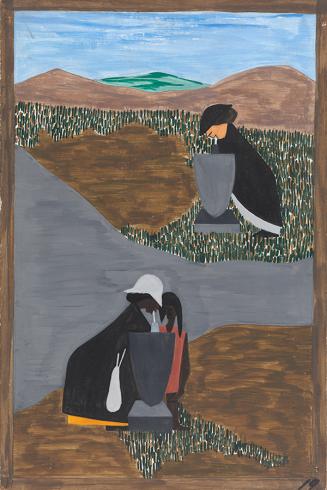
Mikelai Miller, 11th Grade, Thurgood Marshall Academy
Imagine waking up at the crack of dawn, rising up for another day’s work. You make your way to the field for another grueling day. You pick and pick, and it seems that time is at a standstill. Having a young child helps you through the day’s work. Being a parent is your only escape. You must cherish your child while you can, because many children die in their youth. Life is not promised. So you work from sunup to sundown to please the landowner and keep your child fed. You look from side to side and see the vast land. Oh, how you want to run into the forest with your child and never look back. But that is not an option—you must work, you must die, and the next generation must repeat. The painful sips of water flow from you to the next generation.
Panel no. 19: There had always been discrimination.
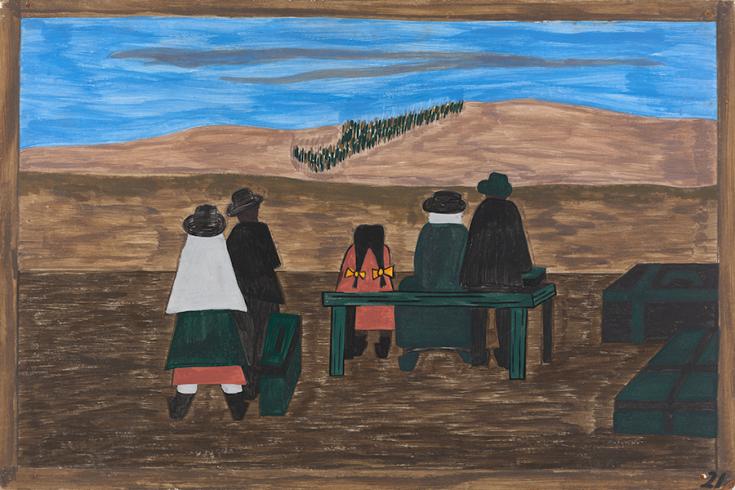
Aaniyah Ryals, 10th Grade, Haynes Public Charter School
The family is leaving from Kentucky and going to New York. It was the grandparents’ idea to leave; they had heard of places called museums and wanted to see one before they died. The mother is sitting just next to her little girl; they are both feeling sad about leaving friends and family behind. Mama looks forward to finding a new job—maybe cooking food somewhere. Her salads are very good. She uses carrots and potatoes from the family garden in her salads. The family garden is also full of roses and tulips. In the big trunk, mama has family pictures and artifacts from the old folks who came before her. The big trunk also has clothes and books for her daughter, who likes to read about history. The family wants to catch the first train that morning and start their journey.
Panel no.21: Families arrived at the station very early. They did not wish to miss their trains north.
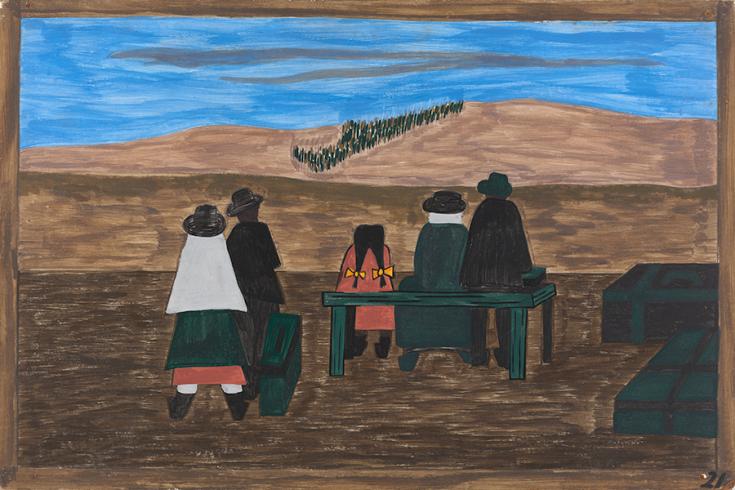
Genet Tewalt, 10th Grade, Washington Latin Public Charter School
Imagine waking up one crisp morning knowing that a place you once called home was going to be left behind and never returned to. When I look at this artwork I feel a sense of sadness and fear but also a twinge of hope. The family in this painting is leaving behind all they know and possibly all they love in hope of a new beginning. The people look off into the distance. They might be imagining their new life ahead of them or trying to forget the life they are leaving behind. I often wonder what makes a place your home when it’s so easy to get up and leave it behind.
Have you ever had to leave behind something or someone you love?
Panel no. 21: Families arrived at the station very early. They did not wish to miss their trains north.
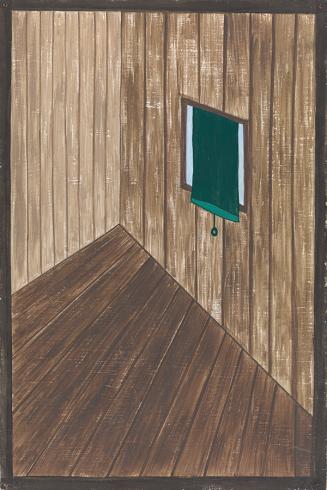
Leah Sloan, 10th Grade, KIPP DC College Prep
This painting shows an empty home. Many had already migrated to the North hoping for a better living situation. But leaving was a big decision. They were unsure of what the life ahead of them would be like. Men didn’t want to leave their families behind and waited until they could migrate together. Some who stayed in the South were monitored by whites, which made them feel pressured to leave sooner. Communities became empty, like this room, without furniture, without the families, who had already migrated North hoping for a better life.
Panel no. 25: They left their homes. Soon some communities were left almost empty.
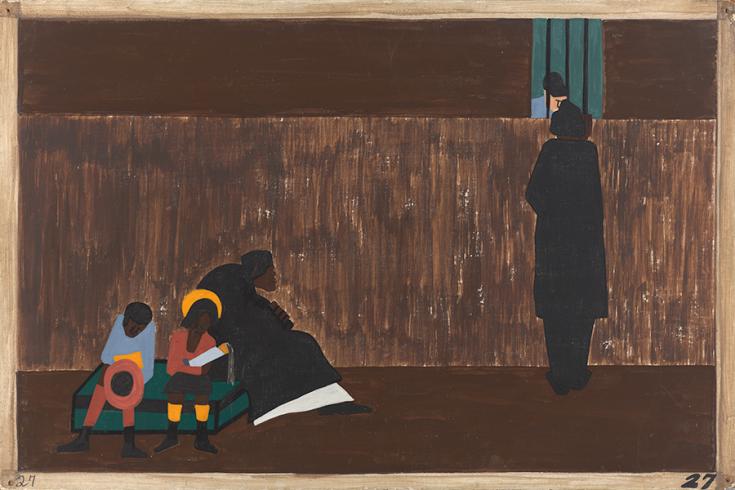
Adena Norwood, 12th Grade, Elizabeth Seton High School
Imagine you finally mustered the courage to leave the oppressive and life-threatening conditions of your home. You now have the opportunity to seek a better and safer life. Now choose which family members go and which stay behind. I could not make such a hard decision; however, this was a decision many Black migrants had to make during the Great Migration.
Consider you are this woman in black, sitting on a trunk with your children. I would feel alone and vulnerable. The children are dressed in vibrant colors, maybe a representation of their naive and unjaded minds during this migration.
Consider you are one of the children in this artwork. What are you thinking? Are you aware of what is going on and what dangers may lie ahead? Are you ready for your new life in the North?
Panel no. 27: Many men stayed behind until they could take their families north with them.
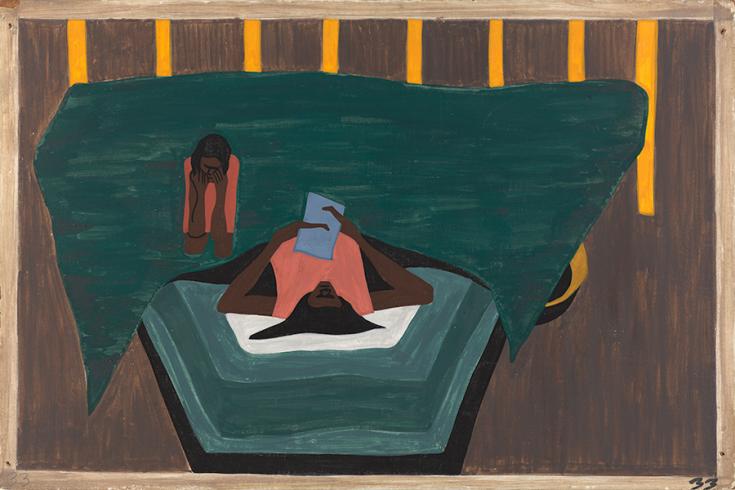
Cosby Hunt, Real World History Teacher at Center for Inspired Teaching
I moved from Philadelphia to rural Georgia in 1993 for my first teaching job—a reverse migration. I arrived at night, a night like I’d never seen before—it was so … very … dark. I was sure that the Boogeyman was jogging through the Georgia woods alongside my car just waiting for it to break down. I wonder if the migrants who moved into tenements in the North felt a similar way about sound. How so very loud their new city lives were. The newcomers exchanged a nighttime quiet interrupted only by crickets and farm animals for the clatter of machinery inside and outside the buildings and the excitement and disagreements of neighbors floating through the air shafts at all times of the day and night. Jacob Lawrence says the housing conditions were “better,” and yet I wonder.
Panel no. 33: Letters from relatives in the North told of the better life there.
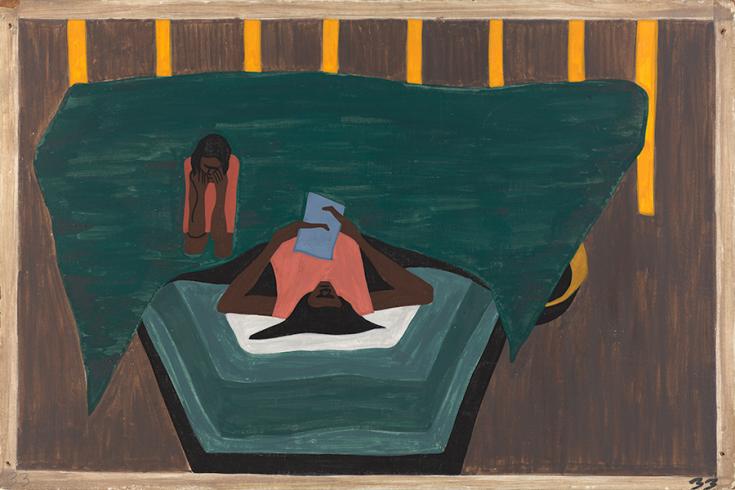
Kayla Park, 11th Grade, Washington Latin Public Charter School
Imagine a world without email or instant messaging. How difficult would it be if you could not instantly check up on your family or share news with friends? During the Great Migration, migrants did not have the luxury of texting or emailing. Instead, they had to write letters to the family they left behind.
The first thing that caught my eye was the young child earnestly listening to her mom as she reads the letter. I can only imagine how anxious they are, finally receiving a long-awaited update about their loved ones in the North. Hopefully they are relieved that they made it to their destination and found a job. Or maybe they are still unsure whether or not migrating was a good choice. Or perhaps now they are one step closer to leaving the South as well.
Panel no. 33: Letters from relatives in the North told of the better life there.
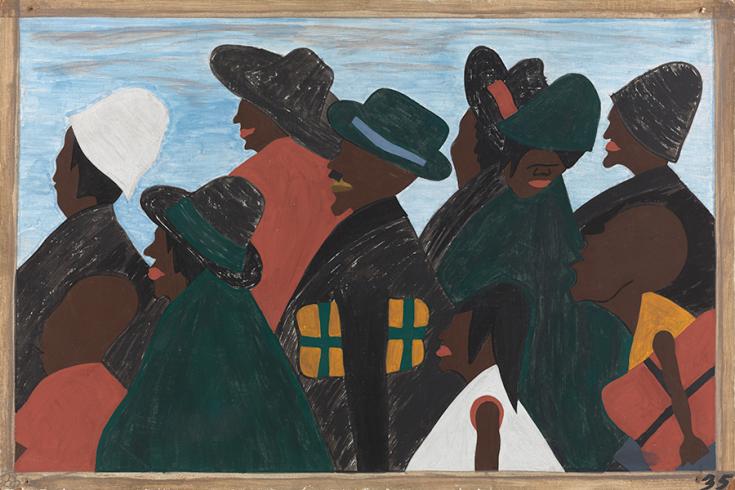
Lakecia Richardson, 11th Grade, Thurgood Marshall Academy Public Charter High School
Imagine if one day you came home and saw your parents, older brother, and Auntie rushing around your house, putting clothes in bags, wrapping food, and trying to find room for other essentials. They tell you to hurry and pack. You ask them why and they say because we are leaving the South. How would you feel? What questions would you ask?
The yellow bag under the middle guy’s arm reminds me of how little they took to start a whole new life in a society that is different from the one they grew up in. I’m curious about what is in the bag. They hold their heads high, with no regret about walking away. They don’t look back because they know that freedom and new life is ahead, giving them courage.
Panel no. 35: They left the South in great numbers. They arrived in the North in great numbers.
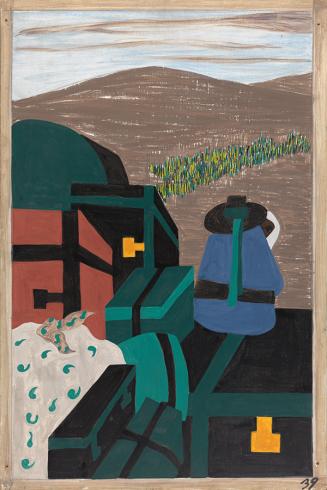
Dylan Paglee, 11th Grade, Washington Latin Public Charter School
Loneliness. The woman and baby sit waiting at a train stop. No one else is around. It is just the two of them with their luggage staring off into nothing. We can’t see the woman’s face, further isolating her from the viewer. The only vibrant colors belong to the two people and their luggage. They don’t fit into the landscape. The two wait at nowhere for something new, perhaps a place with more colors.
Panel no. 39: Railroad platforms were piled high with luggage.
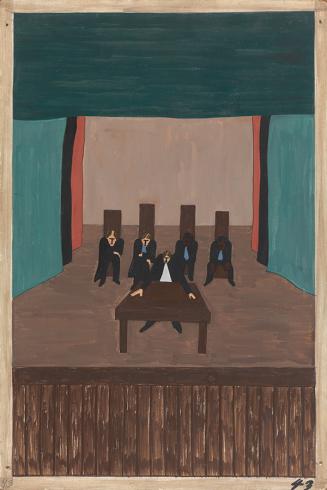
Skyler Wood, 12th Grade, IDEA Public Charter School
When I look at this artwork I feel judged. The tightly drawn faces of the five men seem like they’re frowning at me, examining who I am. Maybe I’m presenting to them or maybe they’re questioning me. Their long-backed chairs remind me of the seats of the justices I saw at the Supreme Court when I visited. I was in the very back of the room but it felt like they sat so high up.
Can you envision yourself standing in front of these men? I wonder—are we supposed to feel like we’re being stared at? Are we, the viewers, the real subject of this artwork?
Panel no. 43: In a few sections of the South leaders of both Black and White communities met to discuss ways of making the South a good place to live.
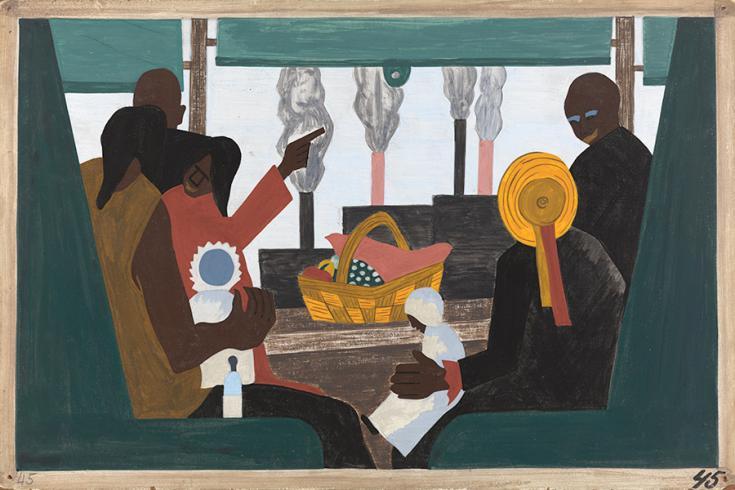
Shaukya Wright, 10th Grade, KIPP College Prep
As you look at this picture, think about your relationship with your family and how much they mean to you. This family has gone through a lot. They are a family of seven on a long train ride with one basket. How much food do you think is in there? Do you think it would last their whole trip north? Maybe … maybe not … Black people did not have a lot of money, and they were not allowed to eat in the train’s dining car. But the only thing that will and should matter during this trip is family.
Panel no. 45: The migrants arrived in Pittsburgh, one of the great industrial centers of the North.
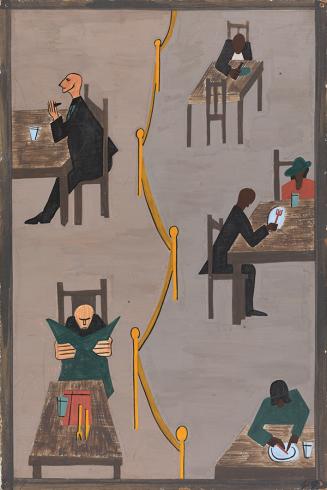
Ally Bleimehl, 11th Grade, Washington Latin Public Charter School
A bright yellow line divides a room. Black and white people are in the same room, yet they remain separate. While the bright yellow rope might seem like nothing compared to the lynchings and KKK in the South, it was a different kind of oppression. Migrants came to the North hoping to be treated more equally. Instead they were met with a different kind of racism.
You are immediately drawn to the rope in the middle. Its bright and warm color usually represents warmth and happiness. But in this case it is a warning: don’t cross the line or even think about the other side. All the people face away from the opposite side, like they don’t even exist. There are many lines humans are not allowed to cross, like when ordering food or waiting for a rollercoaster. But imagine being barred from crossing a line because your skin is a little darker than other people’s.
Panel no. 49: They found discrimination in the North. It was a different kind.
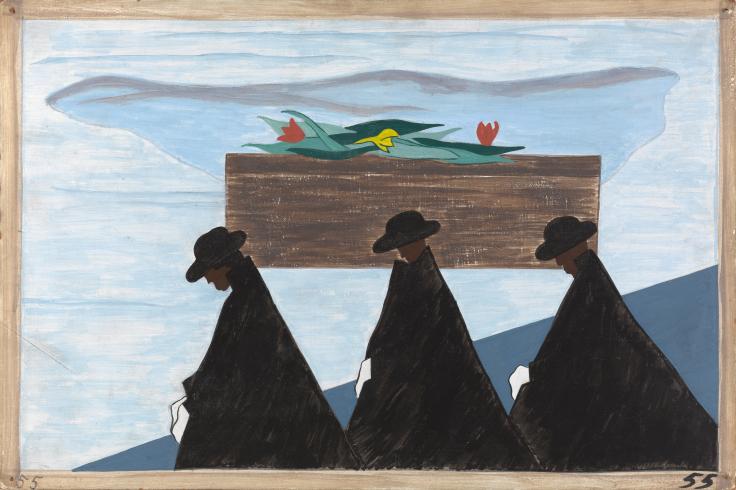
Nile Thaxton, 12th Grade, Washington Latin Public Charter School
Imagine leaving your hometown, the only place you’ve known your whole life. Whether you loved your time there or not, imagine it has become so bad you have to leave. You have your sights set on New York City, a big, growing place where there is more freedom and choice for folks of color. But what may discourage you from going is the alarming rate of tuberculosis killing people. It’s unfathomable to think about a relative or friend traveling up to NYC for the opportunities and freedoms, but then learning they had become another person who died from this lung disease. Black people didn’t have adequate healthcare and lived in crowded homes. In this panel, three men carry a casket. I believe their heads are low because they feel really sad that they couldn’t do anything to help.
The Migration Series, Panel no. 55: The migrants, having moved suddenly into a crowded and unhealthy environment, soon contracted tuberculosis. The death rate rose.
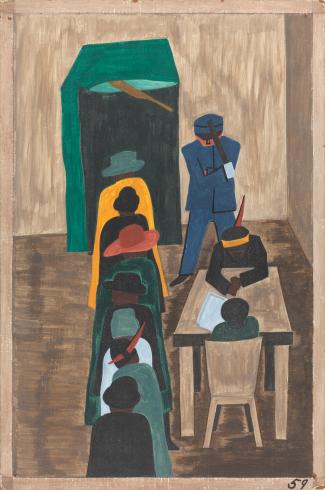
Vivian Claire, 11th Grade Washington Latin Public Charter School
One of the new freedoms migrants acquired upon reaching the North was the right to vote. In the South, white supremacists prevented Black people from voting by enforcing strict voter laws, like the impossible literacy tests of Louisiana. These laws prevented Black people from participating in government and having their voices heard. Many migrants upon reaching the North immediately signed up to vote to start exercising their civil rights as citizens.
In his 59th panel, Jacob Lawrence paints seven people of color standing in line to vote as an intimidating white police officer stands by.Why do you think Lawrence hides the people’s faces? What colors stand out to you? If you were a new migrant in the North, would you be afraid to vote?
The Migration Series, Panel no. 59: In the North they had the freedom to vote.